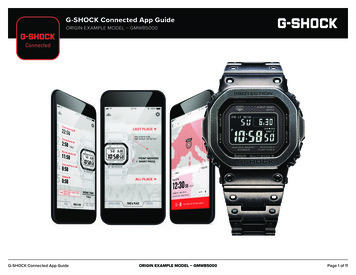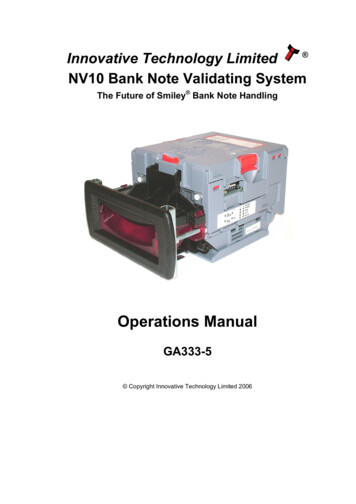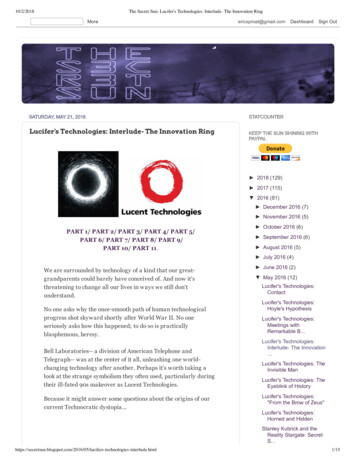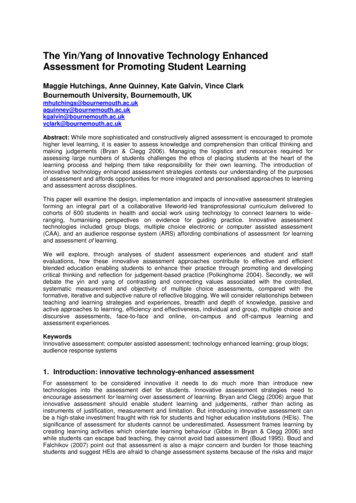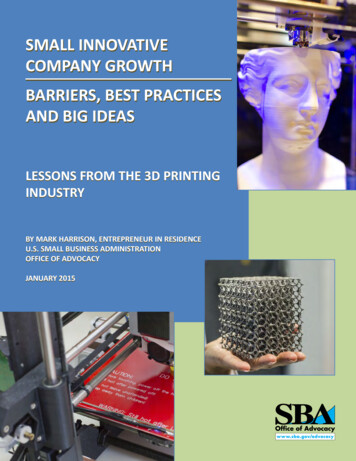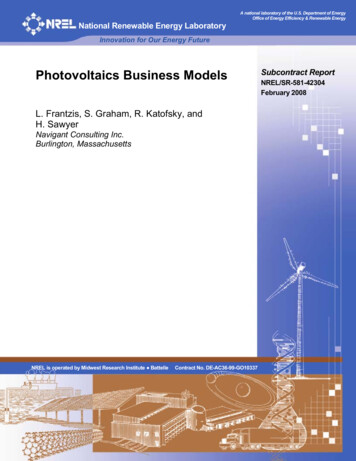
Transcription
Circular AdvantageInnovative Business Models andTechnologies to Create Value ina World without Limits to Growth
Circular AdvantageInnovative Business Models and Technologies to CreateValue without Limits to GrowthExecutive Summaryat a Glance Companies face a rapidly increasingchallenge, and opportunity, to growtheir businesses and create value amidstvolatile and scarce supply of naturalresources and environmental concerns,driving up prices and uncertainty. Circular Economy – an alternativemodel decoupling growth from scarceresource use – provides the key tomanaging this challenge at both themacro and micro level, allowing economicdevelopment within natural resourcelimits and allowing companies to innovateto enable customers and users to do‘more with less’. Accenture’s client experience andresearch show leading global companiesare following the lead of innovativesmaller enterprises, applying the circulareconomy as a framework for growth andinnovation towards ‘Circular Advantage’in what our research shows is already atrillion dollar plus prize. Five circular business models (CircularSupplies, Resource Recovery, Product LifeExtension, Sharing Platforms and Productas a Service) and ten technologies—inparticular ‘digital’ in the form of socialmedia, cloud computing, analytics andmobility—are enabling speed and scale inways not seen before. These business models and technologiesare making possible a fundamentally‘customer-centric’ approach to CircularAdvantage beyond simply efficiency gainswhich require a new mindset amongstexecutives and a new set of capabilitiesat the intersection of strategy, technologyand operations. To understand and capture the fullbusiness opportunity of Circular Economy,top executives need to ask themselvestough questions on the opportunity,value, capabilities, technology and timingof their investments on the journey toCircular Advantage.2
IntroductionThe growth model favored by economiesand indeed most companies for the past250 years—based on the availabilityof plentiful and inexpensive naturalresources—is living on borrowed timeand, so are companies that rely on it.That’s the consensus of research effortsand practical experience of the past twodecades, including our own at Accenture.1This body of research and experience tellsus that when resources are abundantand inexpensive (and the impact onthe environment is not a prevailingconcern), the current “linear” approach tosatisfying demand can be very successful.Companies are able, with ever-increasingefficiency, to extract raw materials,use those materials as inputs to themanufacturing of desired products, andsell and ship those products to as manycustomers as possible (who use anddiscard them after the products haveserved their purpose). Put in shorthand,an economy built on the principles of‘take, make, waste’.However, we are rapidly approaching apoint at which the linear model is nolonger viable: when, due to rising globalaffluence, the availability of many nonrenewables (including metals, minerals,and fossil fuel) cannot keep up withdemand, the regenerative capacity ofrenewables (such as land, forests, water)becomes strained to its limits, and theplanetary boundaries become threatenedas never before. As shown by the IPCC2,US National Climate Assessment3 , andmany others, negative effects of thecurrent growth model are already beingreported on all continents. Accentureresearch4 shows that unless currenttrends are reversed, resource supplydisruptions coupled with rising andincreasingly volatile prices will in the nexttwo decades translate into trillion-dollarlosses for companies and countries whosegrowth remains tied to the use of scarceand virgin natural resources.For businesses and their top executives,responsible for setting the direction oftheir firms, this leads to one inescapableconclusion: Continued dependence onscarce natural resources for growthexposes a company’s tangible andintangible value to serious risks.Examples of Accenture research on the circulareconomy include World Economic Forum, “MoreWith Less: Scaling Sustainable Consumptionand Resource Efficiency,” January 2012 efficiency.aspx); World Business Councilfor Sustainable Development, “Vision 2050:The New Agenda for Business,” February on2050-FullReport Final.pdf); and UnitedNations Global Compact and Accenture, “TheUN Global Compact—Accenture CEO Study onSustainability 2013,” September 2013 inability-2013.PDF)1Intergovernmental Panel on Climate Change,“Climate Change 2014: Impacts, Adaptation, andVulnerability,” October 2013 (http://www.ipcc.ch/report/ar5/wg2/)2 Revenue reduction: Supply uncertaintiesand changing consumer preferencescould prevent companies from generatingrevenues and maintaining market share.For instance, companies that dependheavily on scarce resources might haveto shut down production at times and beunable to deliver demanded volumes. Cost increases: Companies whosegrowth is tightly tied to scarceresources will find themselves at acompetitive disadvantage due to risingand volatile prices that reduce theirability to forecast and compete with lessresource-intensive competitors. Intangible assets: A company’senvironmental footprint and resourcedependence could erode brand valueas consumers shun companies withunsustainable business practices.And, as planetary bottlenecks andresource scarcity become more critical,policymakers likely will favor companiesthat can prove they have positive societalimpact and can operate without depletingthe country’s natural resources.National Climate Assessment, U.S. Global ChangeResearch Program, “Climate Change Impacts in theUnited States,” (http://nca2014.globalchange.gov/)3Modeling for this paper is done using data fromthe United Nations Population Division, WorldBank, HSBC “World in 2050,” OECD long-termoutlook (Economic Outlook No 93 - June 2013 Long-term baseline projections), Global FootprintNetwork, IPCC, The Conference Board, “The totaleconomy database,” and Krausmann, F., Gingrich,S., Eisenmenger, N., Erb, K.H., Haberl, H., FischerKowalski, M. “Growth in global materials use, GDPand population during the 20th century.” The modeluses population and economic growth from 19612050 together with resource intensity variables forbiomass, fossil energy, ores and industrial minerals,and construction minerals to forecast futuredemand per resource category. Improvements inresource intensity have been included to allowsimulation of various technological developmentscenarios. Global resource availability has beenmodeled by connecting ecological footprint datato economic output and checking against resourcereserve estimates. Ninety percent of constructionmineral volumes are removed to adjust for nonscarce resources such as sand and gravel. Arelatively weak stabilization trajectory is used for thispaper, where movement to a one-planet economystarts in 2016 and is reached not before 2050.43
What’s the alternative?The answer is thecircular economy.In a circular economy, growth isdecoupled from the use of scarceresources through disruptive technologyand business models based on longevity,renewability, reuse, repair, upgrade,refurbishment, capacity sharing, anddematerialization. Companies nolonger focus mainly on driving morevolume and squeezing out cost throughgreater efficiency in supply chains,factories and operations. Rather, theyconcentrate on rethinking products andservices from the bottom up to “futureproof” their operations to prepare forinevitable resource constraints – allthe way through to the customer valueproposition. This implies eliminatingwaste, creating step changes inresource productivity and at the sametime enhancing the customer valueproposition on dimensions such as price,quality and availability.By design, circular economy modelsrequire companies to become highlyinvolved in the use and disposal ofproducts, finding ways to move revenuegeneration from selling the physicalstuff to providing access to it and/oroptimizing its performance along theentire value chain. Take a conventionalpower drill as a telling case. A powerdrill is typically used for less than 20minutes during its life cycle5 and whilecustomers need a hole in the wall –the market supplies millions of toolscollecting dust most of the time. If,instead, users had convenient access toa high-quality tool only when needed,they could save money and time whilethe product could be optimized forlongevity, component reuse, recycling,GPS tracking for finding the nearesttool, user communities for advice,mobile payments to simplify pick-up anddrop-off. This thinking can be appliedto anything from DIY tools to trucks,4buildings, printers, etc. Once a businessgoes circular, every aspect of it mustbe configured with the use and returnin mind in addition to production andselling. In this sense the circular economybrings about a massive re-alignment ofcustomer and business incentives – nomore intentionally designing productsto break down, for obsolescence ordisregarding externalities.Many companies across the globe havealready adopted circular principles toclose the loop on energy and materialthrough efforts such as renewableenergy investments and recycling.What’s making this space truly exciting?Pioneering innovators have realizedthe circular economy is not only aboutresource supply and use efficiency,but indeed even more about evolvingtheir business models to transformthe nature of resource demand fromthe customer’s point of view, as in thecase of the power tool. Research byAccenture has identified more than 100truly disruptive companies applyingcircular economy thinking and newtechnology to transform in ways thatseriously threaten incumbents. We callthe competitive edge these companiesgain the “circular advantage”. Net-net,the circular advantage comes throughinnovating for both resource efficiencyand customer value—delivering atthe heart of a company’s strategy,technology and operations.Take, for instance, Nike, which hasworked for years on ways to balancethe dual demands of resourceproductivity and value delivered tocustomers. This pursuit has fosterednumerous innovations that haveboosted the performance of productsin the marketplace while reducing theproducts’ environmental impact. Oneexample is Nike’s FlyknitTM technology,which enables the company to createa shoe upper out of a few singlethreads. The result is a less-wasteful(by 80 percent) production processthat renders a better-fitting and lightershoe that can help boost an athlete’sperformance. Flyknit and similar effortsreflect the central role circular thinkingplays in Nike’s business. “We build ourbusiness by decoupling our growth fromresources that are becoming increasinglyscarce,” wrote Hanna Jones, Nike’s vicepresident of Sustainable Innovation, ina post on the Nike blog. “This isn’t oursustainability strategy, it’s integral toour business strategy.”6Circular thinking also drives the verymission of Novozymes, a world leaderin biotechnology. The company focuseson applying innovation in biorefining tohelp the world shift from an economybased on non-renewable (linear) oilto one that uses renewable (circular)plant- and waste-derived food, feed,fuel and materials instead. Novozymessees such activity as the cornerstoneof a bigger renewable economy thatcan “replace oil, strengthen security offood and energy supplies, create ‘green’jobs, increase incomes and ensure greengrowth—all at the same time.” Amongthe most compelling by-products ofthis growth strategy is a 75 million-tonreduction in CO2 emissions by 2015through its customers’ application ofNovozymes’ products.7
Our research on Nike, Novozymes andothers like them reveals three keythings businesses need to understand tosuccessfully play in the circular economy:1. The emergence of five circular businessmodels available to companies2. The role of five new businesscapabilities required to deliver them3. The disruptive power of ten digital andengineering technologies enabling changeWhen used together the three shape newvalue chains—less exposed to resourcesupply risks, more focused on customervalue creation and with more attractivecost structures. These new value chainscan result in massive productivity gains.How much? Up to four times the amount—enough to tackle the estimated 40 billionton material shortage we’ll reach by 2050.Not a bad advantage considering that ina typical modern manufacturing companymaterials make up around 40 percentof total costs, compared to less than 20percent for labor.Thomas L. Friedman, “Welcome to the SharingEconomy,” The New York Times, July 20, gewanted all& r 0)5World Economic Forum, “How can companiesleave a lighter footprint?” January 24, 2014 ighter-footprint-world/)6Novozymes, “Biobased economy: Replacing an oilbased with a green economy,” 2014 x)7Nike Flyknit5
Calculating the Value of the Circular EconomyIn the past few years, several notablestudies8 have produced estimates of theoverall value of the circular economy,often with diverging results. The reasonfor this is a lack of common definition,which means the resulting estimatesdepend on the boundaries applied tothe circular economy—key assumptionsunderlying the analysis, and analyticalapproach. Most commonly, bottom-upcalculations are made using representativeproducts, material or industries and, assuch, are not comparable to studies usingother industries, material and products asstarting points. In many cases, the focusis on material cost savings (i.e., a wasteand recycling perspective)—an importantaspect, but one that does not provide thefull picture. Across the studies, however,we conclude that the circular economy hasthe potential to become a trillion-dollaropportunity globally in the near future.In our latest research, Accenture hastaken a top-down approach based on aholistic definition of the circular economyand an analysis of the different waysin which resource supply and demandpatterns can be shifted by it. Thisapproach enabled us to get the broadestview of value potential and where it sits.Our research found that for the globaleconomy, the full set of circular economyapproaches can add over five timesthe value of current best estimates by2030 by reducing resource constraintsto growth. A detailed set of data will bemade available in a forthcoming bookbut we can now reveal that this value isdivided into four broad areas (Figure 1).1. Lasting resources that can becontinuously regenerated over time tonot only last longer (efficiency) but lastforever (effectiveness) (e.g., renewableenergy and biochemicals): Approximately40 percent of total value2. Liquid markets where products andassets are optimally utilized by becomingeasily accessible and convertible betweenusers (e.g., sharing / trading idle productand asset capacity): 10 percent3. Long life cycles where products aremade to last (e.g., monetizing productlongevity through service, upgrade andremanufacturing): 30 percent4. Linked value chains where zero wasteis generated from production to disposal(e.g., boosting recycling and resourceefficiency) 20 percentFigure 1: Areas of value creation in the circular economyMultipleusersLasting resourcesBreaking the link between resourcescarcity and economic activity by usingonly resources that can be continuouslyregenerated for productive useLiquid marketsEliminating idle time of products in themarkets in order to grow the number ofusers that gain benefit from the samevolume of goodsLinked value chainsMinimizing resource value destruction ina value chain by reclaiming and linkingup waste outputs as useful inputs intoa next life production processLonger life cyclesKeeping products in economic use forlonger to satisfy a greater demand andprovide more utility without needingadditional natural resources6
The Trouble with the Prevailing Growth ModelThere are volumes of research thathighlight the problem of increasingresource scarcity and mounting waste.9Accenture’s own analysis confirms thestrong relationship between resourceconsumption and GDP (Figure 2). In fact,historically for every 1 percent increase inGDP, resource usage has risen on average0.4 percent.10 This means populationand economic growth are key driversof resource demand. Clearly, economicdevelopment as we know it and resourcescarcity are on a collision course.The world is already using approximately1.5 planet’s worth of resources everyyear. Based on the current pace, we’llconsume three planets by 2050.12 It’s anunsustainable scenario, especially giventhe lack of disruptive innovations on thehorizon that can scale quickly enough tochange the trajectory.Ellen MacArthur Foundation, “Towards theCircular Economy,” Volumes 1 and 2, 20122013, reports/ce2012 and eports/ce2013); The Netherlands Organisation for AppliedScientific Research, “Opportunities for a CircularEconomy in the Netherlands,” 2013 economy-in-the-netherlands.html); Waste &Resources Action Programme (http://www.wrap.org.uk/content/eu-vision-2020); Lin Huocan and LiuCheng, “Circular Economy Poised for Rapid Growth,”China Economic Net, June 29, 2012 (http://en.ce.cn/Insight/201206/29/t20120629 23449603.shtml); World Economic Forum & Accenture, “Morewith Less: Scaling Sustainable Consumption andResource Efficiency”, 20128Fortunately, commodity prices have beenhistorically inversely related to growth.Costs declined automatically. But around2000 this relationship reversed (Figure3), making reliance on resources forgrowth increasingly unattractive.11 As agrowing population and expanding globalmiddle class drive demand for resources,these trends will continue and ultimatelythreaten continuation of business as usual.Among those who have already exploredthe connection between growth and resourceconsumption include The Club of Rome (http://www.clubofrome.org/), Ernst U.von Weizsacker inFactor Four: Doubling Wealth, Halving Resource ing-Resource/dp/1853834068), Walter R.Stahel in The Performance Economy rR-Stahel/dp/0230584667), The Ellen MacArthurFoundation (http://www.ellenmacarthurfoundation.org/), and the United Nations EnvironmentProgramme’s International Resource Panel (http://www.unep.org/resourcepanel/)9Accenture analysis based on data from SERI andDittrich, M. (2014). Global Material Flow Database.2014 version and World Bank GDP data, http://data.worldbank.org/1011Accenture analysis based on data from WorldBank, Commodity Price Data (The Pink Sheet),April 2014 version12Global Footprint Network (2012)Figure 2: Around the world, the link between increased resource use and growth is evidentLog plot of Resource use and Economic development, 166 azilGermany10ColombiaIndiaNigerR-Squared: 0,57P-Value: ic development7
Along with this excessive andunsound use of natural resourcesare myriad environmental problems:soil degradation, water acidification,air pollution, waste generation andcarbon emissions, to name a few.These are leading to a transgressionof the nine key planetary boundariesidentified and quantified by a team of28 internationally renowned scientists.13We’ve passed three already—rate ofbiodiversity loss, climate change, andhuman interference with the nitrogencycle14, threatening abrupt or irreversibleenvironmental changes that canhave far-reaching social andeconomic consequences.If nothing is done to address thesituation, total demand for limitedresource stocks (like biomass, fossilenergy, and many metals) is expectedto reach 130 billion tons by 2050.That’s up from 50 billion in 2014 andit will result in more than 400 percentoveruse of Earth’s total capacity—afeat that’s physically impossible. Evenwith a relatively optimistic forecastfor technological innovation andimprovements in resource efficiency,demand for limited resources will be 80billion tons with an overuse of around40 billion tons by 2050 (Figure 4).The economic impact of resource scarcityon this scale would be devastating.8Needless to say theeconomic impact ofresource scarcity onthis scale would planetary-boundaries.html1314Ibid.
Figure 3: After the year 2000, a new trend in the growth and resource use dynamic can be seenCommodity price & GDP index 1975-2013Index(2010 100)2001975-2000For every 1% growth in GDPcommodity price index fell 0.5%2000-2013For every 1% growth in GDPcommodity price index rose 1,9%1501005001975 1976 1978 1980 1982 1984 1986 1988 1990 1992 1994 1996 1998 2000 2002 2004 2006 2008 2010 2012 2013Energy, Food, Raw Materials,Fertilizers, Metals & Minerals,Precious MetalsCommodity indexGDP indexFigure 4: The widening gap between sustainable resource availability and demandResource supply / demand imbalance 2015-2050Bn TonsDemandAvailabilityRising costs formaterial, energy,land, water908070Business as usualsupply gap605040Extreme volatility incommodity omic andsocial risk of supplydisruptionsScenarios include limited resource stocks only and therefore differ from total materialconsumption. Most notably exclude construction mineral volumes (e.g. sand and gravel)where scarcity is not an issue9
The Circular Economy:The End of Business as UsualBusiness as usual simply cannot continue.Governments and companies aroundthe world are looking for alternativeapproaches to drive future growth. Thecircular economy is one of the few viableand scalable growth models that canradically improve resource productivity toreverse these trends. And, in the process,drive greater innovation and job creation.Better yet, it promises to transformthe dynamics of competitiveness andbestow real competitive advantage toearly movers. In the case of the EU, forexample, it has been estimated thatevery one percent increase in resourceefficiency is worth as much as 23 billioneuro for business and can create up totwo hundred thousand jobs.15At its core, the circular economy is aboutcreating new value chains that decouplegrowth from the use of scarce and linearresource inputs—i.e., inputs that cannot be10returned and used in cyclical chains. Thiscan be accomplished in a number of ways.For instance, a company could promoteusing ”lasting” resources to break the linkbetween scarcity and economic activity byusing only inputs that can be continuouslyreused, reprocessed, or renewed forproductive use (e.g. renewable energy,biomaterial or fully recycled / recyclableresources). Or it could create more“liquidity” in markets by making productsand assets more accessible and easy toconvert between users—eliminating idletime and increasing the number of peoplewho benefit from a given volume ofgoods. It could develop linked value chains,reclaiming and looping back waste outputsas useful inputs into a new productionprocess. Or it could simply extend theuseful life cycle of existing products.To be sure, the intent of these circularvalue chains is nothing new. Many ofthe underlying concepts of the circulareconomy—“cradle to cradle,” industrialecology, biomimicry and others—have been around for decades andmeritoriously explored by pioneers likeBill McDonough, Michael Braungart,Walter R. Stahel and Ellen MacArthur.But what makes the circular economy soripe for widespread adoption now are thedisruptive technologies that allow massivechange—change that would have beenimpossible only a decade ago. Change atspeed and scale. One obvious example:the emergence of digital as a growingeconomic phenomenon around theworld. Many companies have made greatprogress in adopting digital technologiesto dramatically improve aspects of theirbusiness. Such efforts really only scratchthe surface of what’s possible if oneconsider how companies can now alsouse social, mobile, machine-to-machine
communication, etc. to interact withthe marketplace and products in use toanalyze and optimize value chains, andcreate greater customer value.Consider the case of connecting physicalproducts to the digital grid. Remoteaccess, monitoring, and information ona product’s status and location—whichused to require manual work to handle—is now available instantly. Transactioncosts drop significantly16 since servicescan be provided only when needed andon the products that need them. Userscan access products without interactingwith a person, and products can “talk” toeach other through machine-to-machinecommunication which enables, amongstother things, automatic management ofsystems of products or components.When transaction costs are reduced andinformation availability increases (andeconomic activity is decoupled fromvirgin resources), the need for a largescale central organizing infrastructureis minimized, or decentralized. Businessmodels can now be designed in newways: Instead of focusing on largeinventories of homogenous goodsshipped and sold at central locations,a business model can be created, forexample, that focuses on the customerand the products’ use. Circular inputsused in production also tend to be morelocal (renewable energy, biomass, andwaste streams) than linear inputs (oil,virgin metals, and minerals), furthersupporting decentralized business modelsfocusing on a local chain of production,consumption and return.In this new environment the unit costof resources becomes less of a factorbecause instead of using additionalresources to manufacture new goods,companies and customers use what’salready in the market. Focus shifts fromproducing things from virgin resources totransferring existing products betweenusers and transforming used productsinto new ones.Macroeconomic modelling of sustainabledevelopment and the links between the economyand the environment, ENV.F.1/ETU/2010/0033,Bernd Meyer, November 2011 (http://ec.europa.eu/environment/enveco/studies modelling/pdf/exec sum macroeconomic.pdf)1516Some argue costs will often go all the waydown to zero, “speeding us to an era of nearlyfree goods and services.” See Jeremy Rifkin, TheZero Marginal Cost Society: The Internet of Things,the Collaborative Commons, and the Eclipse ofCapitalism, Palgrave Macmillan, 2014 ollaborative/dp/1137278463)11
Five Business Models Drivingthe Circular EconomyAt a conceptual level, then, there isa strong and intuitive business casebehind the circular economy both in theshort and long-term: What companywouldn’t want to reduce its dependenceon increasingly scarce and costlynatural resources while turning wasteinto additional revenue and value andsharpening their customer insight andvalue proposition?But at a practical level, it’s not easy.The fact is most companies today aresimply not built to capitalize on theopportunities the circular economypresents. Their strategies, structures andoperations are deeply rooted in the linearapproach to growth—it’s in their DNA.That’s why companies seeking the circularadvantage will need to develop businessmodels that are free of the constraints oflinear thinking. These models are not justabout doing ‘less bad’, but they are aboutdriving positive impact ‘through growth’.That’s a concept business and economiescan get behind.There are five underlying business modelsthat Accenture has identified in itsanalysis of more than 120 case studies ofcompanies that are generating resourceproductivity improvements in innovativeways (Figure 5).17Figure 5: The five circular business modelsBusiness ModelsCircular Supplies: Provide renewable energy,bio based- or fully recyclable inputmaterial to replace single-lifecycle inputsCircularsuppliesResource Recovery: Recover usefulresources/energy out of disposedproducts or by-productsProduct Life Extension: Extendworking lifecycle of products andcomponents by repairing, upgradingand resellingOtherloopB. Wasteas a resourceProductdesign* Can be applied to product flows in any part of the value chainManufacturingLogisticsA. ResellProcurementSharing Platforms: Enable increasedutilization rate of products by makingpossible shared use/access/ownershipProduct as a Service*: Offer product accessand retain ownership to internalisebenefits of circular resource productivityC. ReturningbyproductsC. RemanufactureB. Repair/UpgradeProductuseA. Re-/upcycleShareReverselogisticsEnd of lifedisposalWasteleakage(eliminate)12Sales andmarketing
These business models have their own distinct characteristics and can be used singlyor in combination to help companies achieve massive resource productivity gainsand, in the process, enhance differentiation and customer value, reduce cost to serveand own, generate new revenue, and reduce risk.Circular SuppliesResource RecoveryThe Circular Supplies business modelis based on supplying fully renewable,recyclable, or biodegradable resourceinputs that underpin circular productionand consumption systems. Throughit, companies replace linear resourceapproaches and phase out the use ofscarce resources while cutting waste,and removing inefficiencies. This model ismost powerful for companies dealing withscarce commodities or ones with a majorenvironmental footprint.Recovery of embedded value at the end ofone product lifecycle to feed into a
Innovative Business Models and Technologies to Create Value without Limits to Growth Executive Summary . the current "linear" approach to satisfying demand can be very successful. Companies are able, with ever-increasing . 4 Modeling for this paper is done using data from the United Nations Population Division, World Bank, HSBC "World .


